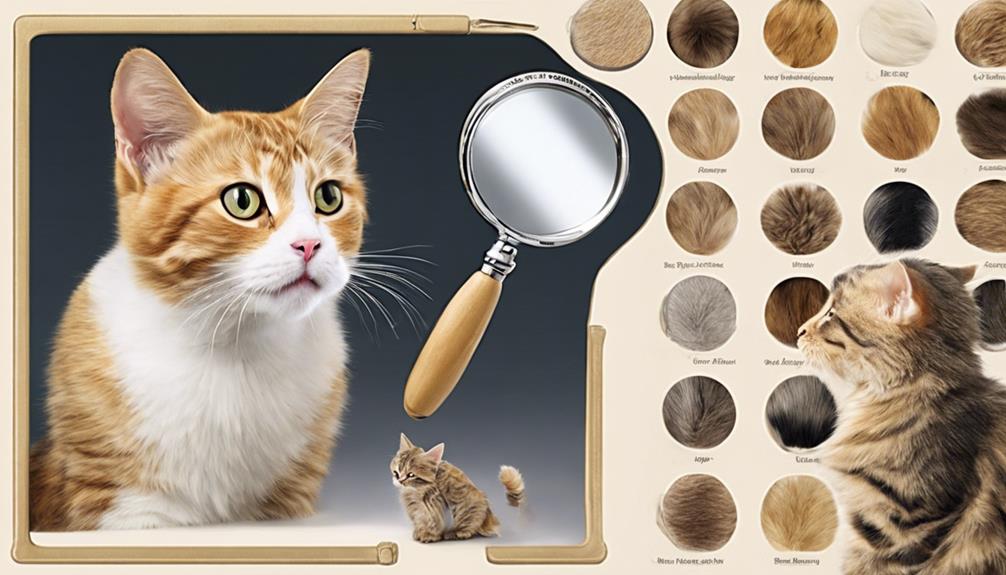When determining the breed of our beloved cat, we can look at its size, fur color, ear shape, and eye color to discover key clues.
Looking into these physical characteristics can lead to some insightful revelations about our feline friend.
Key Takeaways
- Observe size, fur color, and markings for breed clues.
- Utilize online resources like TICA and CFA for breed information.
- Consider physical characteristics like coat length and eye color.
- Explore genetic markers and DNA tests for accurate identification.
- Mixed breed cats offer unique genetic backgrounds and characteristics.
Identifying Physical Characteristics
When identifying the physical characteristics of your cat, observe its size, fur color, and markings as key indicators for determining its breed.
Start by noticing whether your cat has long or short hair. Cats with long hair are often associated with specific breeds like Maine Coons or Persians, while short-haired cats can be linked to breeds such as Siamese or Abyssinian.
Additionally, pay attention to your cat's ear shape; for instance, pointed ears may suggest a Siamese or Scottish Fold heritage. Eye color is another crucial clue in identifying your cat's breed. Certain breeds like the Turkish Van are known for their striking amber eyes, while Siamese cats typically have alluring blue eyes.
Researching Online Breed Resources

To further identify your cat's breed accurately, turn to online resources such as The International Cat Association (TICA) and Cat Fanciers' Association (CFA) for detailed breed information. These reputable organizations offer extensive databases on various breeds like the American Shorthair, Maine Coon, and Scottish Fold, complete with breed standards and characteristics.
Additionally, exploring specialized websites and forums dedicated to cat breeds can provide valuable insights and discussions from experienced breeders and enthusiasts.
For a more personalized approach, consider joining breed-specific clubs and organizations affiliated with TICA or CFA. These clubs often offer detailed breed standards, photos, and access to breed experts who can assist you in identifying your cat's breed accurately.
Online tools such as cat breed identification quizzes and databases can also help narrow down potential matches based on your cat's physical traits and behavior.
Understanding Cat Breed Characteristics
Understanding cat breed characteristics involves recognizing variations in size, fur colors, patterns, hair length, face shapes, and ear features. When identifying cat breeds, here are some key points to take into account:
- Size Variations: Cats can range from small or dwarf breeds like the Munchkin to large breeds like the Maine Coon, with medium-sized breeds like the Ragdoll falling in between.
- Coat Patterns: Different coat patterns such as solid, bi-color, tortoiseshell, calico, and points can provide clues to a cat's breed heritage.
- Hair Length: Cat breeds can have varying hair lengths, from long-haired beauties like the Persian to short-haired breeds like the Siamese, or even hairless breeds like the Sphynx.
- Facial Features and Ear Shapes: Unique facial structures like flat-faced Persians or narrow-faced Siamese, coupled with distinctive ear shapes such as curled Scottish Folds or tufted Maine Coons, play a significant role in identifying specific cat breeds.
Understanding these characteristics can assist in narrowing down the potential breeds your beloved feline friend may belong to.
Using At-Home Tools for Identification

Exploring the option of utilizing at-home tools for identification offers cat owners a convenient and insightful way to uncover their cat's breed through genetic markers. Cat DNA tests can accurately analyze coat length, fur patterns, and specific breed traits to help identify your cat's lineage. These tests not only reveal your cat's breed but also provide valuable information on potential health risks associated with specific breeds.
Exploring Mixed Breed Possibilities
Mixed breed cats exhibit a fascinating blend of genetic traits inherited from their diverse lineage, making them uniquely special companions. When exploring mixed breed possibilities, there are several key points to take into account:
- Diverse Genetic Backgrounds: Mixed breed cats can have a wide range of genetic backgrounds, leading to a unique combination of traits.
- Identification through Physical Traits: Recognizing physical characteristics from different breeds can offer clues to a mixed breed cat's ancestry.
- Benefit of Hybrid Vigor: Mixed breed cats often benefit from hybrid vigor, which can reduce the likelihood of certain inherited health conditions.
- Enhanced Bond with Owners: Understanding a mixed breed cat's background can deepen the bond between cat and owner, creating a more fulfilling relationship.
Frequently Asked Questions
How Can I Find a Mate for My Cat?
We'll thoroughly consider our cat's needs and personality to find a suitable mate. Seeking advice from professionals like veterinarians or breeders guarantees we make informed decisions. Health screenings and genetic testing are crucial for healthy offspring.
What Cat Breeds Should I Get as a First Time Cat Owner?
As first-time cat owners, we recommend considering common breeds like Domestic Shorthair or Longhair. These types make up a majority of feline pets in the U.S., are not pedigreed, and can offer a wonderful pet experience.
How Do I Know When to Breed My Cat?
Like a compass seeking true north, we assess our cat's readiness for breeding. Consulting with experts, considering age, health, and temperament, we navigate responsibly. Prioritizing well-being and preparedness, we proceed mindfully.
What Breed of Cat Came First?
We believe the Egyptian Mau was the first recognized cat breed. Dating back to ancient Egypt, these majestic felines hold a special place in history. Their unique markings and demeanor set them apart from other breeds.
How Can Knowing My Cat’s Breed Help Me Better Understand its Behavior and Care Needs?
Understanding your cat’s breed can unlock cat care secrets unlocked, as different breeds have unique behavior traits and care needs. Knowing your cat’s breed can help you provide better care, address specific health concerns, and tailor your interaction and training to better suit your cat’s individual needs.
Conclusion
In the colorful tapestry of cat breeds, identifying our feline friends can be a journey of discovery and delight. By deciphering the clues hidden within their fur and features, we reveal the secrets of their ancestry and heritage.
So, seize your magnifying glass and commence on this exciting adventure of unraveling the mystery of your beloved cat's breed. Who knows what surprises and revelations await in the world of whiskers and purrs?










